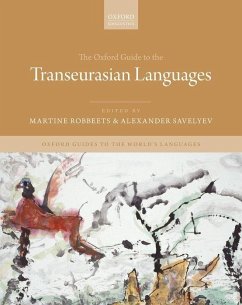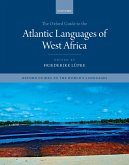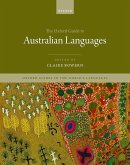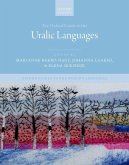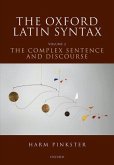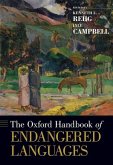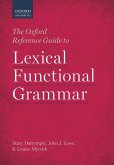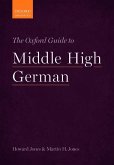The Oxford Guide to the Transeurasian Languages
Herausgeber: Robbeets, Martine; Savelyev, Alexander
The Oxford Guide to the Transeurasian Languages
Herausgeber: Robbeets, Martine; Savelyev, Alexander
- Gebundenes Buch
- Merkliste
- Auf die Merkliste
- Bewerten Bewerten
- Teilen
- Produkt teilen
- Produkterinnerung
- Produkterinnerung
This volume provides a comprehensive treatment of the Transeurasian languages. It offers detailed structural overviews of individual languages, as well as comparative perspectives and insights from typology, genetics, and anthropology. The book will be an indispensable resource for anyone interested in Transeurasian and comparative linguistics.
Andere Kunden interessierten sich auch für
![The Oxford Guide to the Atlantic Languages of West Africa The Oxford Guide to the Atlantic Languages of West Africa]() The Oxford Guide to the Atlantic Languages of West Africa219,99 €
The Oxford Guide to the Atlantic Languages of West Africa219,99 €![The Oxford Guide to Australian Languages The Oxford Guide to Australian Languages]() The Oxford Guide to Australian Languages219,99 €
The Oxford Guide to Australian Languages219,99 €![The Oxford Guide to the Uralic Languages The Oxford Guide to the Uralic Languages]() The Oxford Guide to the Uralic Languages247,99 €
The Oxford Guide to the Uralic Languages247,99 €![The Oxford Latin Syntax The Oxford Latin Syntax]() Harm PinksterThe Oxford Latin Syntax270,99 €
Harm PinksterThe Oxford Latin Syntax270,99 €![Oxford Handbook of Endangered Languages Oxford Handbook of Endangered Languages]() Oxford Handbook of Endangered Languages251,99 €
Oxford Handbook of Endangered Languages251,99 €![Oxford Reference Guide to Lexical Functional Grammar Oxford Reference Guide to Lexical Functional Grammar]() Mary DalrympleOxford Reference Guide to Lexical Functional Grammar253,99 €
Mary DalrympleOxford Reference Guide to Lexical Functional Grammar253,99 €![Oxford Guide to Middle High German Oxford Guide to Middle High German]() Howard JonesOxford Guide to Middle High German211,99 €
Howard JonesOxford Guide to Middle High German211,99 €-
-
-
This volume provides a comprehensive treatment of the Transeurasian languages. It offers detailed structural overviews of individual languages, as well as comparative perspectives and insights from typology, genetics, and anthropology. The book will be an indispensable resource for anyone interested in Transeurasian and comparative linguistics.
Hinweis: Dieser Artikel kann nur an eine deutsche Lieferadresse ausgeliefert werden.
Hinweis: Dieser Artikel kann nur an eine deutsche Lieferadresse ausgeliefert werden.
Produktdetails
- Produktdetails
- Verlag: Oxford University Press
- Seitenzahl: 976
- Erscheinungstermin: 26. August 2020
- Englisch
- Abmessung: 277mm x 221mm x 58mm
- Gewicht: 2676g
- ISBN-13: 9780198804628
- ISBN-10: 0198804628
- Artikelnr.: 59513141
- Herstellerkennzeichnung
- Libri GmbH
- Europaallee 1
- 36244 Bad Hersfeld
- gpsr@libri.de
- Verlag: Oxford University Press
- Seitenzahl: 976
- Erscheinungstermin: 26. August 2020
- Englisch
- Abmessung: 277mm x 221mm x 58mm
- Gewicht: 2676g
- ISBN-13: 9780198804628
- ISBN-10: 0198804628
- Artikelnr.: 59513141
- Herstellerkennzeichnung
- Libri GmbH
- Europaallee 1
- 36244 Bad Hersfeld
- gpsr@libri.de
Martine Robbeets is Research Group Leader at the Max Planck Institute for the Science of Human History in Jena and Honorary Professor in Transeurasian Linguistics at the University of Mainz. She currently leads the eurasia3angle research project, which explores the dispersal of the Transeurasian languages and is funded by the European Research Council. Her publications include Is Japanese related to Korean, Tungusic, Mongolic and Turkic? (Harrassowitz, 2005), Diachrony of Verb Morphology: Japanese and the Transeurasian Languages (De Gruyter, 2015), and several edited volumes. Alexander Savelyev is a postdoctoral researcher at the Max Planck Institute for the Science of Human History in Jena. He obtained his PhD from the Institute of Linguistics of the Russian Academy of Sciences in 2015 and joined the eurasia3angle research project in 2016. He currently works on cultural reconstruction of the Proto-Turkic language and its Transeurasian connections, and on verifying the internal structure of the Turkic language family. His other research interests include historical grammar and dialectology of Chuvash, language contact in the Volga-Kama Basin, and documentation of Siberian Turkic languages.
* Detailed Contents
* Series Preface
* List of Figures and Tables
* List of Abbreviations
* Romanization Conventions
* The Contributors
* Introduction
* Part I: Sources and Classification
* A: Historical Sources and Periodization
* 1: Marc Miyake: Historical sources and periodization of the Japonic
and Koreanic languages
* 2: Volker Rybatzki: The Altaic languages: Tungusic, Mongolic, Turkic
* B: Genealogical Classification
* 3: Martine Robbeets: The classification of the Transeurasian
languages
* 4: Elisabeth M. de Boer: The classification of the Japonic languages
* 5: Kyou-Dong Ahn and Jaehoon Yeon: The classification of the Korean
language and its dialects
* 6: Lindsay J. Whaley and Sofia Oskolskaya: The classification of the
Tungusic languages
* 7: Hans Nugteren: The classification of the Mongolic languages
* 8: Lars Johanson: The classification of the Turkic languages
* 9: Alexander Savelyev: A Bayesian approach to the classification of
the Turkic languages
* C: Typology
* 10: Martine Robbeets: The typological heritage of the Transeurasian
languages
* 11: Nataliia Hübler: Typological profile of the Transeurasian
languages from a quantitative perspective
* Part II: Individual Structural Overviews
* 12: Masayoshi Shibatani: Japanese and the mainland dialects
* 13: Yuto Niinaga: Amami and Okinawa, the Northern Ryukyuan languages
* 14: John R. Bentley: Miyako, Ishigaki, and Yonaguni, the Southern
Ryukyuan languages
* 15: Ho-min Sohn: Korean and the Korean dialects
* 16: Ubong Shin, Jieun Kiaer, and Jiyoung Shin: Jejudo Korean
* 17: Taeho Jang: Xibe and the Manchuric languages
* 18: Brigitte Pakendorf and Natalia Aralova: Even and the Northern
Tungusic languages
* 19: Sofia Oskolskaya: Nanai and the Southern Tungusic languages
* 20: Yohei Yamada: Dagur
* 21: Jan-Olof Svantesson: Khalkha Mongolian
* 22: Ágnes Birtalan: Oirat and Kalmyk, the Western Mongolic languages
* 23: Éva A. Csató and Lars Johanson: The northwestern Turkic (Kipchak)
languages
* 24: Jaklin Kornfilt: Turkish and the southwestern Turkic (Oghuz)
languages
* 25: Abdurashid Yakup: Uyghur and Uzbek, the southeastern Turkic
languages
* 26: Brigitte Pakendorf and Eugénie Stapert: Sakha and Dolgan, the
North Siberian Turkic languages
* 27: Alexander Savelyev: Chuvash and the Bulgharic languages
* Part III: Comparative Overviews
* A: Phonology
* 28: Allan R. Bomhard: A comparative approach to the consonant
inventory of the Transeurasian languages
* 29: Andrew Joseph, Seongyeon Ko, and John Whitman: A comparative
approach to the vowel systems and harmonies in the Transeurasian
languages and beyond
* B: Morphology
* 30: Martine Robbeets: A comparative approach to verbal morphology in
Transeurasian
* 31: Ilya Gruntov and Olga Mazo: A comparative approach to nominal
morphology in Transeurasian: Case and plurality
* 32: Michal Schwarz, Ond¿ej Srba, and Václav Blazek: A comparative
approach to the pronominal system in Transeurasian
* C: Syntax
* 33: Irina Nevskaya and Lina Amal: The nominal group, possessive
agreement, and nominal sentences in the Transeurasian languages
* 34: Andrej Malchukov and Patryk Czerwinski: Verbal categories in the
Transeurasian languages
* 35: Andrej Malchukov and Patryk Czerwinski: Complex constructions in
the Transeurasian languages
* D: Lexicon and Semantics
* 36: Martine Robbeets: Basic vocabulary in the Transeurasian languages
* 37: Václav Blazek: Numerals in the Transeurasian languages
* 38: Milan van Berlo: Kinship term paradigms in the Transeurasian
languages
* Part IV: Areal Versus Inherited Connections
* 39: Alexander T. Francis-Ratte and J. Marshall Unger: Contact between
genealogically related languages: the case of Old Korean and Old
Japanese
* 40: Gregory D. S. Anderson: Form and pattern borrowing across
Siberian Turkic, Mongolic, and Tungusic languages
* 41: Edward Vajda: Transeurasian as a continuum of diffusion
* 42: Cecil H. Brown: Beck-Wichmann-Brown evaluation of lexical
comparisons for the Transeurasian proposal
* Part V: Interdisciplinary Perspectives on the Identity of
Transeurasian
* 43: Martine Robbeets, Juha Janhunen, Alexander Savelyev, and Evgeniya
Korovina: The homelands of the individual Transeurasian
proto-languages
* 44: Martine Robbeets: The Transeurasian homeland: Where, what and
when?
* 45: Choongwon Jeong, Chuan-Chao Wang, and Chao Ning: Transeurasian
unity from a population genetic perspective
* 46: Tao Li: Transeurasian unity from an archaeological perspective
* 47: Mark James Hudson: Language dispersals and the 'Secondary
Peoples' Revolution': A historical anthropology of the Transeurasian
unity
* References
* Index
* Series Preface
* List of Figures and Tables
* List of Abbreviations
* Romanization Conventions
* The Contributors
* Introduction
* Part I: Sources and Classification
* A: Historical Sources and Periodization
* 1: Marc Miyake: Historical sources and periodization of the Japonic
and Koreanic languages
* 2: Volker Rybatzki: The Altaic languages: Tungusic, Mongolic, Turkic
* B: Genealogical Classification
* 3: Martine Robbeets: The classification of the Transeurasian
languages
* 4: Elisabeth M. de Boer: The classification of the Japonic languages
* 5: Kyou-Dong Ahn and Jaehoon Yeon: The classification of the Korean
language and its dialects
* 6: Lindsay J. Whaley and Sofia Oskolskaya: The classification of the
Tungusic languages
* 7: Hans Nugteren: The classification of the Mongolic languages
* 8: Lars Johanson: The classification of the Turkic languages
* 9: Alexander Savelyev: A Bayesian approach to the classification of
the Turkic languages
* C: Typology
* 10: Martine Robbeets: The typological heritage of the Transeurasian
languages
* 11: Nataliia Hübler: Typological profile of the Transeurasian
languages from a quantitative perspective
* Part II: Individual Structural Overviews
* 12: Masayoshi Shibatani: Japanese and the mainland dialects
* 13: Yuto Niinaga: Amami and Okinawa, the Northern Ryukyuan languages
* 14: John R. Bentley: Miyako, Ishigaki, and Yonaguni, the Southern
Ryukyuan languages
* 15: Ho-min Sohn: Korean and the Korean dialects
* 16: Ubong Shin, Jieun Kiaer, and Jiyoung Shin: Jejudo Korean
* 17: Taeho Jang: Xibe and the Manchuric languages
* 18: Brigitte Pakendorf and Natalia Aralova: Even and the Northern
Tungusic languages
* 19: Sofia Oskolskaya: Nanai and the Southern Tungusic languages
* 20: Yohei Yamada: Dagur
* 21: Jan-Olof Svantesson: Khalkha Mongolian
* 22: Ágnes Birtalan: Oirat and Kalmyk, the Western Mongolic languages
* 23: Éva A. Csató and Lars Johanson: The northwestern Turkic (Kipchak)
languages
* 24: Jaklin Kornfilt: Turkish and the southwestern Turkic (Oghuz)
languages
* 25: Abdurashid Yakup: Uyghur and Uzbek, the southeastern Turkic
languages
* 26: Brigitte Pakendorf and Eugénie Stapert: Sakha and Dolgan, the
North Siberian Turkic languages
* 27: Alexander Savelyev: Chuvash and the Bulgharic languages
* Part III: Comparative Overviews
* A: Phonology
* 28: Allan R. Bomhard: A comparative approach to the consonant
inventory of the Transeurasian languages
* 29: Andrew Joseph, Seongyeon Ko, and John Whitman: A comparative
approach to the vowel systems and harmonies in the Transeurasian
languages and beyond
* B: Morphology
* 30: Martine Robbeets: A comparative approach to verbal morphology in
Transeurasian
* 31: Ilya Gruntov and Olga Mazo: A comparative approach to nominal
morphology in Transeurasian: Case and plurality
* 32: Michal Schwarz, Ond¿ej Srba, and Václav Blazek: A comparative
approach to the pronominal system in Transeurasian
* C: Syntax
* 33: Irina Nevskaya and Lina Amal: The nominal group, possessive
agreement, and nominal sentences in the Transeurasian languages
* 34: Andrej Malchukov and Patryk Czerwinski: Verbal categories in the
Transeurasian languages
* 35: Andrej Malchukov and Patryk Czerwinski: Complex constructions in
the Transeurasian languages
* D: Lexicon and Semantics
* 36: Martine Robbeets: Basic vocabulary in the Transeurasian languages
* 37: Václav Blazek: Numerals in the Transeurasian languages
* 38: Milan van Berlo: Kinship term paradigms in the Transeurasian
languages
* Part IV: Areal Versus Inherited Connections
* 39: Alexander T. Francis-Ratte and J. Marshall Unger: Contact between
genealogically related languages: the case of Old Korean and Old
Japanese
* 40: Gregory D. S. Anderson: Form and pattern borrowing across
Siberian Turkic, Mongolic, and Tungusic languages
* 41: Edward Vajda: Transeurasian as a continuum of diffusion
* 42: Cecil H. Brown: Beck-Wichmann-Brown evaluation of lexical
comparisons for the Transeurasian proposal
* Part V: Interdisciplinary Perspectives on the Identity of
Transeurasian
* 43: Martine Robbeets, Juha Janhunen, Alexander Savelyev, and Evgeniya
Korovina: The homelands of the individual Transeurasian
proto-languages
* 44: Martine Robbeets: The Transeurasian homeland: Where, what and
when?
* 45: Choongwon Jeong, Chuan-Chao Wang, and Chao Ning: Transeurasian
unity from a population genetic perspective
* 46: Tao Li: Transeurasian unity from an archaeological perspective
* 47: Mark James Hudson: Language dispersals and the 'Secondary
Peoples' Revolution': A historical anthropology of the Transeurasian
unity
* References
* Index
* Detailed Contents
* Series Preface
* List of Figures and Tables
* List of Abbreviations
* Romanization Conventions
* The Contributors
* Introduction
* Part I: Sources and Classification
* A: Historical Sources and Periodization
* 1: Marc Miyake: Historical sources and periodization of the Japonic
and Koreanic languages
* 2: Volker Rybatzki: The Altaic languages: Tungusic, Mongolic, Turkic
* B: Genealogical Classification
* 3: Martine Robbeets: The classification of the Transeurasian
languages
* 4: Elisabeth M. de Boer: The classification of the Japonic languages
* 5: Kyou-Dong Ahn and Jaehoon Yeon: The classification of the Korean
language and its dialects
* 6: Lindsay J. Whaley and Sofia Oskolskaya: The classification of the
Tungusic languages
* 7: Hans Nugteren: The classification of the Mongolic languages
* 8: Lars Johanson: The classification of the Turkic languages
* 9: Alexander Savelyev: A Bayesian approach to the classification of
the Turkic languages
* C: Typology
* 10: Martine Robbeets: The typological heritage of the Transeurasian
languages
* 11: Nataliia Hübler: Typological profile of the Transeurasian
languages from a quantitative perspective
* Part II: Individual Structural Overviews
* 12: Masayoshi Shibatani: Japanese and the mainland dialects
* 13: Yuto Niinaga: Amami and Okinawa, the Northern Ryukyuan languages
* 14: John R. Bentley: Miyako, Ishigaki, and Yonaguni, the Southern
Ryukyuan languages
* 15: Ho-min Sohn: Korean and the Korean dialects
* 16: Ubong Shin, Jieun Kiaer, and Jiyoung Shin: Jejudo Korean
* 17: Taeho Jang: Xibe and the Manchuric languages
* 18: Brigitte Pakendorf and Natalia Aralova: Even and the Northern
Tungusic languages
* 19: Sofia Oskolskaya: Nanai and the Southern Tungusic languages
* 20: Yohei Yamada: Dagur
* 21: Jan-Olof Svantesson: Khalkha Mongolian
* 22: Ágnes Birtalan: Oirat and Kalmyk, the Western Mongolic languages
* 23: Éva A. Csató and Lars Johanson: The northwestern Turkic (Kipchak)
languages
* 24: Jaklin Kornfilt: Turkish and the southwestern Turkic (Oghuz)
languages
* 25: Abdurashid Yakup: Uyghur and Uzbek, the southeastern Turkic
languages
* 26: Brigitte Pakendorf and Eugénie Stapert: Sakha and Dolgan, the
North Siberian Turkic languages
* 27: Alexander Savelyev: Chuvash and the Bulgharic languages
* Part III: Comparative Overviews
* A: Phonology
* 28: Allan R. Bomhard: A comparative approach to the consonant
inventory of the Transeurasian languages
* 29: Andrew Joseph, Seongyeon Ko, and John Whitman: A comparative
approach to the vowel systems and harmonies in the Transeurasian
languages and beyond
* B: Morphology
* 30: Martine Robbeets: A comparative approach to verbal morphology in
Transeurasian
* 31: Ilya Gruntov and Olga Mazo: A comparative approach to nominal
morphology in Transeurasian: Case and plurality
* 32: Michal Schwarz, Ond¿ej Srba, and Václav Blazek: A comparative
approach to the pronominal system in Transeurasian
* C: Syntax
* 33: Irina Nevskaya and Lina Amal: The nominal group, possessive
agreement, and nominal sentences in the Transeurasian languages
* 34: Andrej Malchukov and Patryk Czerwinski: Verbal categories in the
Transeurasian languages
* 35: Andrej Malchukov and Patryk Czerwinski: Complex constructions in
the Transeurasian languages
* D: Lexicon and Semantics
* 36: Martine Robbeets: Basic vocabulary in the Transeurasian languages
* 37: Václav Blazek: Numerals in the Transeurasian languages
* 38: Milan van Berlo: Kinship term paradigms in the Transeurasian
languages
* Part IV: Areal Versus Inherited Connections
* 39: Alexander T. Francis-Ratte and J. Marshall Unger: Contact between
genealogically related languages: the case of Old Korean and Old
Japanese
* 40: Gregory D. S. Anderson: Form and pattern borrowing across
Siberian Turkic, Mongolic, and Tungusic languages
* 41: Edward Vajda: Transeurasian as a continuum of diffusion
* 42: Cecil H. Brown: Beck-Wichmann-Brown evaluation of lexical
comparisons for the Transeurasian proposal
* Part V: Interdisciplinary Perspectives on the Identity of
Transeurasian
* 43: Martine Robbeets, Juha Janhunen, Alexander Savelyev, and Evgeniya
Korovina: The homelands of the individual Transeurasian
proto-languages
* 44: Martine Robbeets: The Transeurasian homeland: Where, what and
when?
* 45: Choongwon Jeong, Chuan-Chao Wang, and Chao Ning: Transeurasian
unity from a population genetic perspective
* 46: Tao Li: Transeurasian unity from an archaeological perspective
* 47: Mark James Hudson: Language dispersals and the 'Secondary
Peoples' Revolution': A historical anthropology of the Transeurasian
unity
* References
* Index
* Series Preface
* List of Figures and Tables
* List of Abbreviations
* Romanization Conventions
* The Contributors
* Introduction
* Part I: Sources and Classification
* A: Historical Sources and Periodization
* 1: Marc Miyake: Historical sources and periodization of the Japonic
and Koreanic languages
* 2: Volker Rybatzki: The Altaic languages: Tungusic, Mongolic, Turkic
* B: Genealogical Classification
* 3: Martine Robbeets: The classification of the Transeurasian
languages
* 4: Elisabeth M. de Boer: The classification of the Japonic languages
* 5: Kyou-Dong Ahn and Jaehoon Yeon: The classification of the Korean
language and its dialects
* 6: Lindsay J. Whaley and Sofia Oskolskaya: The classification of the
Tungusic languages
* 7: Hans Nugteren: The classification of the Mongolic languages
* 8: Lars Johanson: The classification of the Turkic languages
* 9: Alexander Savelyev: A Bayesian approach to the classification of
the Turkic languages
* C: Typology
* 10: Martine Robbeets: The typological heritage of the Transeurasian
languages
* 11: Nataliia Hübler: Typological profile of the Transeurasian
languages from a quantitative perspective
* Part II: Individual Structural Overviews
* 12: Masayoshi Shibatani: Japanese and the mainland dialects
* 13: Yuto Niinaga: Amami and Okinawa, the Northern Ryukyuan languages
* 14: John R. Bentley: Miyako, Ishigaki, and Yonaguni, the Southern
Ryukyuan languages
* 15: Ho-min Sohn: Korean and the Korean dialects
* 16: Ubong Shin, Jieun Kiaer, and Jiyoung Shin: Jejudo Korean
* 17: Taeho Jang: Xibe and the Manchuric languages
* 18: Brigitte Pakendorf and Natalia Aralova: Even and the Northern
Tungusic languages
* 19: Sofia Oskolskaya: Nanai and the Southern Tungusic languages
* 20: Yohei Yamada: Dagur
* 21: Jan-Olof Svantesson: Khalkha Mongolian
* 22: Ágnes Birtalan: Oirat and Kalmyk, the Western Mongolic languages
* 23: Éva A. Csató and Lars Johanson: The northwestern Turkic (Kipchak)
languages
* 24: Jaklin Kornfilt: Turkish and the southwestern Turkic (Oghuz)
languages
* 25: Abdurashid Yakup: Uyghur and Uzbek, the southeastern Turkic
languages
* 26: Brigitte Pakendorf and Eugénie Stapert: Sakha and Dolgan, the
North Siberian Turkic languages
* 27: Alexander Savelyev: Chuvash and the Bulgharic languages
* Part III: Comparative Overviews
* A: Phonology
* 28: Allan R. Bomhard: A comparative approach to the consonant
inventory of the Transeurasian languages
* 29: Andrew Joseph, Seongyeon Ko, and John Whitman: A comparative
approach to the vowel systems and harmonies in the Transeurasian
languages and beyond
* B: Morphology
* 30: Martine Robbeets: A comparative approach to verbal morphology in
Transeurasian
* 31: Ilya Gruntov and Olga Mazo: A comparative approach to nominal
morphology in Transeurasian: Case and plurality
* 32: Michal Schwarz, Ond¿ej Srba, and Václav Blazek: A comparative
approach to the pronominal system in Transeurasian
* C: Syntax
* 33: Irina Nevskaya and Lina Amal: The nominal group, possessive
agreement, and nominal sentences in the Transeurasian languages
* 34: Andrej Malchukov and Patryk Czerwinski: Verbal categories in the
Transeurasian languages
* 35: Andrej Malchukov and Patryk Czerwinski: Complex constructions in
the Transeurasian languages
* D: Lexicon and Semantics
* 36: Martine Robbeets: Basic vocabulary in the Transeurasian languages
* 37: Václav Blazek: Numerals in the Transeurasian languages
* 38: Milan van Berlo: Kinship term paradigms in the Transeurasian
languages
* Part IV: Areal Versus Inherited Connections
* 39: Alexander T. Francis-Ratte and J. Marshall Unger: Contact between
genealogically related languages: the case of Old Korean and Old
Japanese
* 40: Gregory D. S. Anderson: Form and pattern borrowing across
Siberian Turkic, Mongolic, and Tungusic languages
* 41: Edward Vajda: Transeurasian as a continuum of diffusion
* 42: Cecil H. Brown: Beck-Wichmann-Brown evaluation of lexical
comparisons for the Transeurasian proposal
* Part V: Interdisciplinary Perspectives on the Identity of
Transeurasian
* 43: Martine Robbeets, Juha Janhunen, Alexander Savelyev, and Evgeniya
Korovina: The homelands of the individual Transeurasian
proto-languages
* 44: Martine Robbeets: The Transeurasian homeland: Where, what and
when?
* 45: Choongwon Jeong, Chuan-Chao Wang, and Chao Ning: Transeurasian
unity from a population genetic perspective
* 46: Tao Li: Transeurasian unity from an archaeological perspective
* 47: Mark James Hudson: Language dispersals and the 'Secondary
Peoples' Revolution': A historical anthropology of the Transeurasian
unity
* References
* Index

